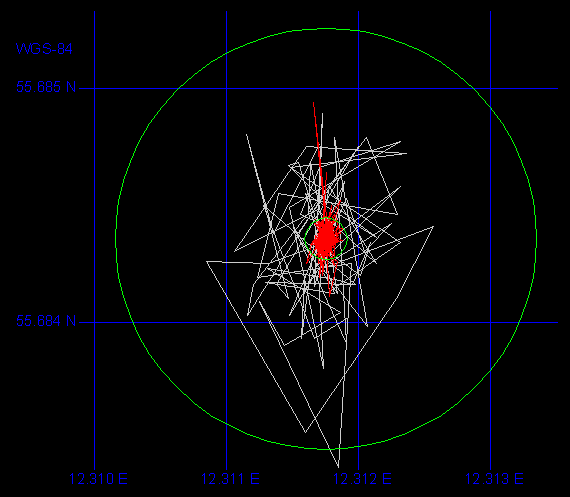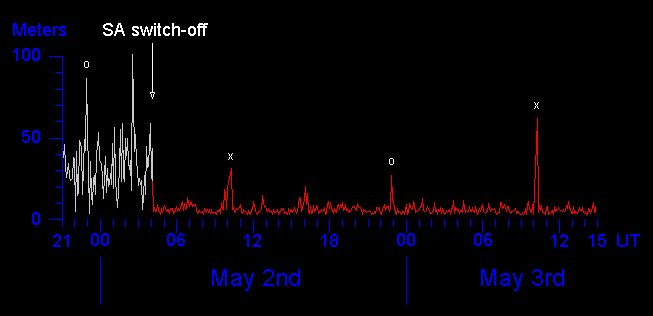 |
Fig. 1: GPS positions before and after SA switch-off Gray trace is before and red trace is after switch-off. Red spikes are explained below. Green circles indicate 10 and 100 meter distances from no-SA average position. Datum: WGS-84. |
Increased GPS Accuracy for
Civil Users
Niels Foldager, Copenhagen, Denmark
The Department of Defence of United States have until May 2nd 2000 intentionally degraded the navigation signals from the GPS NAVSTAR satellite system. This led to a dominating inaccuracy of position for civil users. The armed forces of the U.S. used GPS receivers with build-in means to decrypt transmitted error information so achieving much higher precision. The intended degradation of precision is called "selective availability" (SA).
In a press release May 1st, 2000, Bill Clinton announced that U.S. would stop SA at midnight.
I recorded continuously the GPS position from 7 hours before to 35 hours after the SA switch-off with the receiver at a fixed position. The effect of SA switch-off are shown here:
 |
Fig. 1: GPS positions before and after SA switch-off Gray trace is before and red trace is after switch-off. Red spikes are explained below. Green circles indicate 10 and 100 meter distances from no-SA average position. Datum: WGS-84. |
The average position of the 35-hours no-SA part
of the data was used as a base point. The distance to this point
was calculated for all positions recorded. In so far as the base
point is the true position of the receiver, a distance equals the
GPS error at that point of time. Fig. 2 shows the error versus
time:
 |
Fig. 2: Position error versus time Gray part of curve is before and red part is after SA switch-off. Red spikes are due to DOP (see text below). Spikes produced by identical satellite constellations are marked with O and X, respectively. |
The data shows, that SA was switched off the 2nd of May between 4:04 and 4:09 UTC.
The average error was 33.2 m (range: 1.8-108 m) before SA switch-off and 4.5 m (0.5-65 m) after switch-off.
The red error spikes were mainly due to dilution of precision (DOP): bad geometry among the sky positions of the satellites currently used by the receiver. In this study, the antenna could sometimes only see four satellites due to a near-by building. When those four satellites were close to be on a line, DOP increased dramatically. As the orbital period of the satellites is 12 hours, identical satellite constellations (and DOPs) arise with a period of one sidereal day: 23 hours 56 min (X and O on Fig. 2).
DOP is kept low by optimising the position of the antenna. In this case, there would have been no DOP spikes if the antenna had been located just a few meters higher.
In contrast to SA, DOP is predictable. The actual error can be calculated and is indicated on most receivers as estimated position error (EPE) based on the satellites currently used by the receiver.